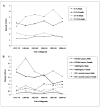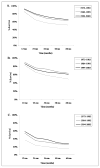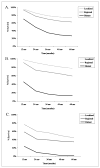Osteosarcoma incidence and survival rates from 1973 to 2004: data from the Surveillance, Epidemiology, and End Results Program
- PMID: 19197972
- PMCID: PMC2813207
- DOI: 10.1002/cncr.24121
Osteosarcoma incidence and survival rates from 1973 to 2004: data from the Surveillance, Epidemiology, and End Results Program
Abstract
Background: Osteosarcoma, which is the most common primary bone tumor, occurs most frequently in adolescents, but there is a second incidence peak among individuals aged > 60 years. Most osteosarcoma epidemiology studies have been embedded in large analyses of all bone tumors or focused on cases occurring in adolescence. Detailed descriptions of osteosarcoma incidence and survival with direct comparisons among patients of all ages and ethnicities are not available.
Methods: Frequency, incidence, and survival rates for 3482 patients with osteosarcoma from the National Cancer Institute's population-based Surveillance, Epidemiology, and End Results (SEER) Program between 1973 and 2004 were investigated by age (ages 0-24 years, 25-59 years, and 60 to > or = 85 years), race, sex, pathology subtype, stage, and anatomic site.
Results: There were large differences in incidence and survival rates by age. There was a high percentage of osteosarcoma with Paget disease and osteosarcoma as a second or later cancer among the elderly. There was a high percentage of osteosarcoma among patients with Paget disease and osteosarcoma as a second or later cancer among the elderly. Tumor site differences among age groups were noted. Survival rates varied by anatomic site and disease stage and did not improve significantly from 1984 to 2004.
Conclusions: This comprehensive, population-based description of osteosarcoma, identified important differences in incidence, survival, pathologic subtype, and anatomic site among age groups, and quantified the impact of osteosarcoma in patients with Paget disease or as a second cancer on incidence and mortality rates. These findings may have implications in understanding osteosarcoma biology and epidemiology.
(c) 2009 American Cancer Society
Figures




References
-
- Sweetnam R. Osteosarcoma. Br J Hosp Med. 1982;28(2):112, 16–21. - PubMed
-
- Mascarenhas L, Siegel S, Spector L, Arndt C, Femino D, Malogolowkin M. Malignant bone tumors: cancer in 15- to 29-year-olds in the United States. In: Bleyer A, OLM Barr R, Ries LAG, editors. Cancer Epidemiology in older adolescents and young adults 15 to 29 years of age, including SEER incidence and survival: 1975–2000. Bethesda, MD: National Cancer Institute; 2006. pp. 98–109. NIH Pub. No. 06-5767.
-
- Dahlin DC, Unni KK. Bone Tumors: general aspects and data on 8,542 cases. 4. Springfield, IL: Thomas; 1986.
-
- Damron TA, Ward WG, Stewart A. Osteosarcoma, Chrondrosarcoma, and Ewing’s Sarcoma. National Cancer Data Base Report. Clin Orthop Relat Res. 2007;459:40–47. - PubMed
-
- Dorfman HA, Czerniak B. Bone Cancers. Cancer supplement. 1995;75(1):203–10. - PubMed
Publication types
MeSH terms
Grants and funding
LinkOut - more resources
Full Text Sources
Other Literature Sources
Medical

